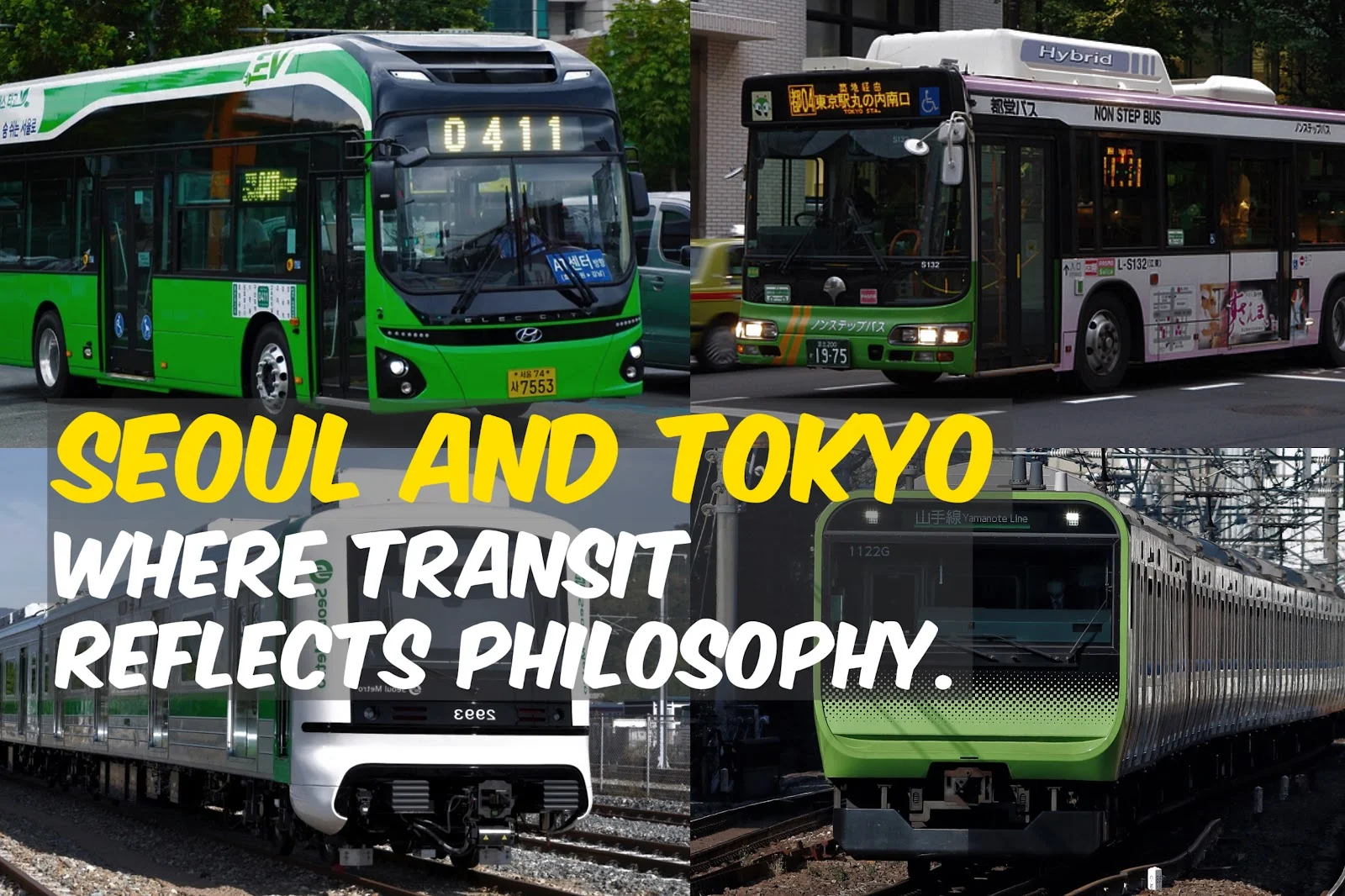— Buses and Subways: Same City, Different Roles
When living abroad, one quickly realizes that a city's transportation system is more than just a way to get around. Especially in cities like Seoul and Tokyo, where public transit is intricately developed, the systems may appear similar on the surface, yet the underlying design philosophies and daily usage patterns differ greatly.
Having lived in both Seoul and Tokyo,
I’ve noticed that in Seoul, buses and subways play equally central roles,
whereas in Tokyo, the subway is the primary mode of transport, with buses serving a supplementary role.
So, where does this difference come from?
Why Are Buses a ‘Main Player’ in Seoul?
Seoul’s public transportation system can be summed up as “parallel operation of buses and subways.” The key point is that neither is merely supplementary; each mode plays an independent yet complementary role.
1. Dense Bus Network — "You Rarely Have to Walk Far"
When moving around Seoul, it's actually harder to find a spot without a bus stop in sight. A wide variety of bus types—blue (trunk), green (branch), red (express), and yellow (circular)—connect the inner city with the outskirts in a 3D web. They’re particularly effective at covering gaps between subway stations and reaching narrow alleys beyond the subway’s reach.
2. Subway Overlap Isn’t a Problem — It’s a Strength
In Seoul, it's common to have multiple options—bus or subway—for reaching the same destination. At first glance, this might seem like redundant planning, but it actually offers users great flexibility. When you feel, “Taking the bus would be better right now,” you can simply choose it without inconvenience.
3. Seamless Transfers with a Unified Fare System
With a single transit card, you can transfer between bus → subway → bus again with almost no additional fare. Thanks to this system, the two modes complement each other instead of competing, optimizing convenience for the public.
Why Are Buses Just a 'Supporting Role' in Tokyo?
Tokyo also boasts an excellent public transit system. But its core framework is built around railways—subways and the JR lines in particular. This is not just an operational choice, but deeply rooted in the city’s historical development pattern.
1. Railway Companies Built the City
In Tokyo, various private railway companies have independently operated their own lines. These companies didn’t just build transportation—they developed residential and commercial zones around their lines, effectively shaping the entire city.
This means that “commuting, shopping, and socializing all revolve around trains.”
2. Buses Exist to Get You to the Train Station
Within Tokyo’s 23 wards, buses are primarily used to reach nearby train stations rather than as a main form of travel. For example, people often take a short bus ride from their home to the nearest station. In other words, it’s uncommon to rely solely on buses to get around central Tokyo.
3. Lack of Transfer Integration
Unlike Seoul, Tokyo doesn’t have a fully integrated fare system, so when transferring between private railways and buses, you may end up paying double fares. This system has led many to perceive buses as inconvenient, resulting in buses playing only a secondary role to railways.
Public Transit from the Perspective of the Elderly and Disabled
Seoul: Ongoing Efforts for Accessibility, But Challenges Remain
Seoul is actively improving accessibility with more elevators, low-floor buses, and audio guidance for the visually impaired. LED arrival displays at bus stops, no-pass alerts, and wheelchair ramps are notable advancements.
However, challenges remain: jerky movements when boarding buses, narrow subway transfer corridors, and unsteady stops can be physically stressful for elderly passengers.
Tokyo: Precision Systems, But Complexity is a Major Barrier
Tokyo offers elevators or wheelchair lifts at all subway stations, and most buses are low-floor models. Yet the main issue lies in the complexity and length of transfer routes.
For instance, transferring at some JR stations can involve stairs, escalators, and crosswalks, taking over 10 minutes. This physical complexity poses a major burden for those with reduced mobility.
Public Transit from a Tourist’s Point of View
Seoul: App-Based Info and Decent English Support
Apps like ‘Kakao Bus’ or ‘Naver Maps’ offer real-time arrivals, route recommendations, and fare estimates. In subways, English announcements are relatively clear, and a single transit card covers all modes of transport.
However, the complex web of routes, crowded rush hours, and inconsistent guidance from bus drivers can be intimidating for first-time foreign visitors.
Tokyo: Many Train Lines, But Hard to Grasp at a Glance
Tokyo has numerous train lines with different operators, which can create uncertainty during transfers. While the ‘Suica’ card covers most travel, unexpected fares may occur if you don’t know which segment is run by which company.
That said, stations are well-maintained, and visual guidance via electronic boards and signage is generally excellent.
Seoul vs Tokyo: A Side-by-Side Comparison
| Category | Seoul | Tokyo |
|---|---|---|
| Main Transit Mode | Subway & Bus Equally Used | Railway-Focused, Bus is Supplementary |
| Transfer System | Integrated Fare, Easy Transfers | Separate Operators, Extra Transfer Fares |
| Accessibility for Elderly | Improving, Yet Some Issues Remain | Precise but Physically Complex Routes |
| Tourist Experience | Good Apps & English Info, Complex Network | Great Visual Guides, Complicated Fare Structure |
Conclusion: Transit Philosophy Shapes the Way of Life
Urban transit design is not just about moving from A to B. It reflects a city’s philosophy on how people live, interact, and connect with one another.
Seoul promotes flexibility and connectivity,
while Tokyo offers efficiency, reliability, and a structured lifestyle.
Both are excellent in their own ways. But by understanding their unique philosophies and infrastructures, we can begin to see cities not just as places to live, but as structures to be read, interpreted, and appreciated.

Comments
Post a Comment